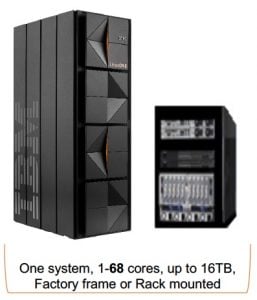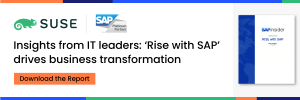New Releases for Business Critical Linux With Enhanced Security and Advanced Function

Today, SUSE announces the general availability of the latest releases in our Business Critical Linux (BCL) family – the SLE family of products (including SUSE Linux Enterprise Server 15 SP5 and SLES for SAP Applications 15 SP5) and SUSE Manager 4.3.6.
These releases are optimized to host workloads across the widest range of environments. And, they provide one of the world’s strongest security postures, giving our customers the essential ingredient in a secure infrastructure as businesses build better multi-channel experiences for their customers. While the entire BCL portfolio has been updated, three solutions worth mentioning are:
SUSE Linux Enterprise Server 15 SP5
Our flagship product, SUSE Linux Enterprise Server, is now available with a brand new service pack. In this release, we focus on security – including driver refreshes to enable hardware features to enhance support for Confidential Computing. In addition, we updated extensions and tools for SUSE Linux Enterprise that help you run your infrastructure better.
For more details and all the updates, check out this blog by Jeff Reser and the documentation page here. For technical details, please refer to the here.
SLES for SAP Applications 15 SP5
SUSE Linux Enterprise Server for SAP Applications is an SAP Endorsed App specifically designed with features to deploy, configure, and manage SAP systems on-premises and in the cloud. The new release of SLES for SAP Applications includes enhancements to Trento to help prevent any downtime of your business critical SAP applications. Trento provides proactive checks and monitoring – an essential piece of day 2 operations for HANA and S/4HANA deployments.
For more details, visit the SLES for SAP Applications documentation page here. And, for technical details, please refer to the release notes here.
SUSE Manager 4.3.6
While this is not a major release of SUSE Manager, it includes some major enhancements. For instance, SUMA 4.3.6 supports not only SLES 15 SP5 but also supports RHEL 9 and all of its derivations. Additionally, this release of SUSE Manager supports recurring salt states and enhanced CVE and openSCAP scanning. SUMA 4.3 will also have extended support – all the way through June 2025. This is particularly important because SUMA 4.2 goes out of support in October 2023.
For more details, check out my blog here and visit the SUSE Manager documentation page here. And, for technical details, please refer to the release notes here.
Downloads Now Available
We’re pleased to provide new releases of our BCL portfolio. We invite you to download them today!
- https://www.suse.com/download/sles/
- Covers SUSE Linux Enterprise Server 15 SP5 on AMD64/Intel 64, Arm, Power, and IBM zSystems & LinuxONE.
- https://www.suse.com/download/sle-sap/
- Covers SUSE Linux Enterprise Server for SAP Applications 15 SP5 on AMD64/Intel 64 and Power.
- https://www.suse.com/download/sled/
- Covers SUSE Linux Enterprise Desktop 15 SP5 on AMD64/Intel 64.
- https://www.suse.com/download/sle-rt/
- Covers SUSE Linux Enterprise Real Time 15 SP5 on AMD64/Intel 64.
- https://www.suse.com/download/sle-hpc/
- Covers SUSE Linux Enterprise High Performance Computing 15 SP5 on AMD64/Intel 64 and Arm.
- https://www.suse.com/download/sle-lp/
- Covers SUSE Linux Enterprise Live Patching 15 SP5 on AMD64/Intel 64, Power, and IBM zSystems & LinuxONE.
- https://www.suse.com/download/sle-ha/
- Covers SUSE Linux Enterprise High Availability Extension 15 SP5 on AMD64/Intel 64, Power, and IBM zSystems & LinuxONE.
- https://www.suse.com/download/suse-manager/
- Covers SUSE Manager 4.3.6 on AMD64/Intel 64, Power, and IBM zSystems & LinuxONE.
- https://www.suse.com/download/sle-micro/
- Covers SUSE Linux Enterprise Micro 5.4 on AMD64/Intel 64, Arm, and IBM zSystems & LinuxONE.
- https://registry.suse.com/
- Covers SUSE Linux Enterprise Base Container Images 15 SP5 on AMD64/Intel 64, Arm, Power, and IBM zSystems & LinuxONE.
We look forward to seeing the adoption of these new releases in the market and we welcome your comments and input!






 The annual Partner Program Guide rating given by CRN includes the most notable partner programs from industry-leading technology vendors that provide innovative products and flexible services through the IT channel. The 5-star rating is only given to vendors that excel in their programs by driving partner focused market opportunity and growth.
The annual Partner Program Guide rating given by CRN includes the most notable partner programs from industry-leading technology vendors that provide innovative products and flexible services through the IT channel. The 5-star rating is only given to vendors that excel in their programs by driving partner focused market opportunity and growth. 